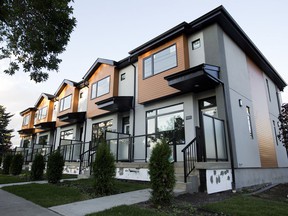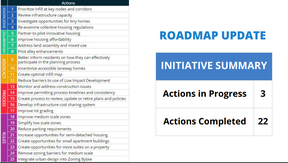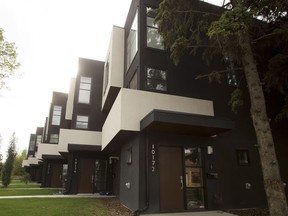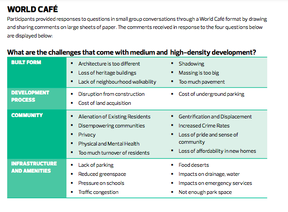
Article content
Edmonton is making progress on infill development, but unless affordability is built into policy, the city may “miss the moment,” according to a planning expert.
advertisement 2
Article content
patrick condon, UBC urban design professortold Postmedia in a recent interview that one of Vancouver’s lessons has been that adding density doesn’t automatically lead to cheaper housing.
Infill is key to reaching the goals set out in the city’s most recent municipal development plan, City Plan, 2020. Building half of all new housing units in mature neighborhoods through infill development, creating a range of housing types and increasing supply, is how the city is preparing for Edmonton’s population to grow to two million. In fact, the city surpassed its previous goal for 25 per cent of new construction as infill in 2020 where 30 per cent of new units fit into this category.
City staff told council last week the completion of the 2018 infill roadmap — with 22 of the 25 actions complete — is a chance to celebrate the progress.
advertisement 3
Article content
Creating tools to improve housing affordability with infill is one of these actions. City staff deemed this item complete for the purpose of the roadmap — although it acknowledges ongoing work is needed — citing the now-completed grant program that led to the construction of 2,500 affordable housing units, approval of a suite of supportive and bridge housing units, and plans to allow supportive housing across the city through zoning changes.
But Condon, also a former Vancouver city planner, said if Edmonton wants to keep housing prices down it needs to be intentional about building affordability into the way land is regulated and focus on “disciplining the land market.”

If upzoning land for higher density alone increases affordability, then Vancouver would be the most affordable city in Canada, Condon said. There are no single-family home zones in Vancouver.
advertisement 4
Article content
“Somebody buys a lot, tears down the existing house with two rental units, and the price of the new duplexes are, in almost every case, more expensive than the single-family home that it replaced,” he said.
In fact, he says increasing density across the city — as Edmonton plans to do by increasing what can be built on every residential lot citywide — may make Edmonton more unaffordable.
“When you authorize that additional density, it changes the market for that parcel (of land), and the price of the parcel goes up in kind,” he said. “The problem of affordability is not the number of buildings we have or don’t have, it’s not the cost of construction, it’s not the drag of the permitting process, it’s the inflation that has occurred all across Canada and all across North America, particularly in major cities, on the price of land.”
advertisement 5
Article content
with the zoning by law renewal in the works, Edmonton has the opportunity to anticipate what may happen with rising land prices and insist on affordability through policy specific to Edmonton’s needs, he said. One measure that has worked elsewhere, he said, is inclusionary zoning. This requires including an affordable housing component whenever properties are zoned to include more density.
“If you miss this moment, you will miss it forever. Because if you turn around in 15 years and say, ‘Oh that didn’t work’ … it will be too late,” Condon said.

Supply and affordability
Sean Bohle, a senior city planner who managed the infill roadmap, doesn’t think increasing density allowed will dramatically affect land prices because there isn’t the same kind of pent-up demand for land as in cities like Vancouver.
advertisement 6
Article content
Many parts of Edmonton already have more development rights than what’s currently on the lot, and the suburbs are where the city is growing, he told Postmedia. But Bohle thinks rising land prices could happen in some areas.
“There will be some neighborhoods and some sites in Edmonton where that’s true and where the regulations change, land values increase a bit, but there is so much opportunity to build things like row housing, etc., that no one landowner is going to be able to corner the market.”
Bohle also doesn’t think that gentrification of lower-income areas is a concern right now. Generally, he said city planners’ approach is understanding that restricting housing supply through tight regulations harms affordability.
advertisement 7
Article content
“We can still create an environment that welcome investment and allows for a broad set of opportunities for housing to help meet people’s needs,” he said. “Because while just a set of regulations can’t produce affordable housing, restricting development to only single detached houses is a recipe for keeping prices permanently high and out of reach of most households.”
Coun. Anne Stevenson said for market-affordable infill housing, there’s a focus on reducing delays for permits and rezonings to streamline development.
“Increasing more opportunities for infill, and decreasing those barriers also help to drive down that cost,” she told Postmedia.

Public concerned about affordability
Edmonton’s 2018 infill roadmap was created through the 20-month-long infill evolving engagement projectwhich showed consistent concern from the public about how infill development may impact home prices.
advertisement 8
Article content
This topic was raised in nearly every public engagement session. For instance, participants in one series of sessions said the city needs to actively address the lack of affordability with new infill. On the flip side, business groups said increased density equals more affordability.
Reflecting the public’s view, the city’s first draft list of actions for the roadmap, released in 2017, included the option to “collaborate with developers to provide more affordable housing options in all neighborhoods.” This was one of the highest-rated actions in workshops with community groups but did not proceed to the final list in this form.
Edmonton’s residential infill policy for mature neighborhoods in 2009 included a requirement for infill projects to have an affordable housing component.